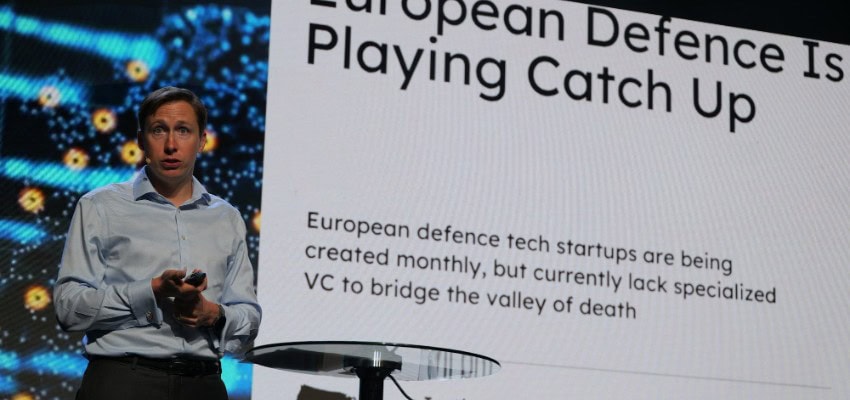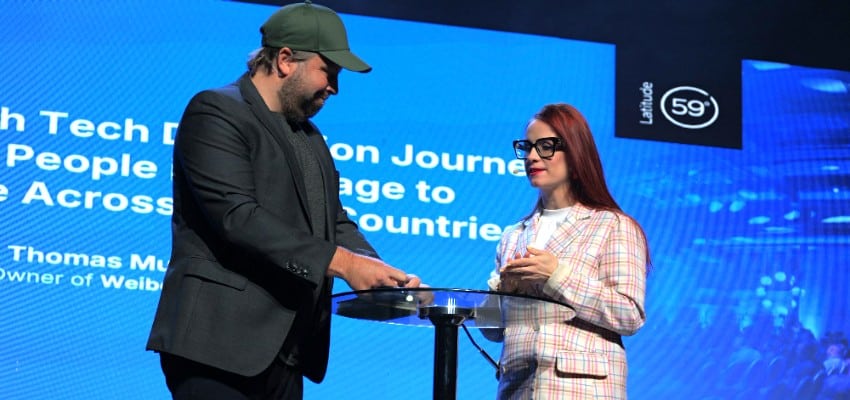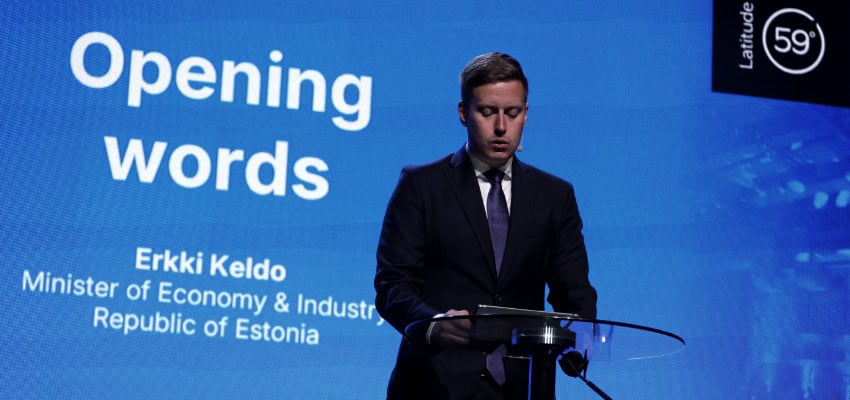Editor’s Note: ComplexDiscovery staff were on-site in Tallinn for Latitude59’s 2025 “Thinking in Billions” event, where defense, innovation, and investment leaders tackled the urgent question of how Europe can strengthen its technological and strategic autonomy. Co-hosted by Estonia’s Ministry of Economic Affairs and Communications and NATO DIANA, the event highlighted Estonia’s leadership while framing its initiatives as a scalable model for broader European action.
This article distills key insights from government ministers, Ukrainian defense technologists, NATO leadership, and European venture investors. From capital deployment and battlefield validation to regulatory reform, their contributions underscored the need for a coordinated European response to evolving threats.
For professionals in cybersecurity, information governance, and eDiscovery, the discussion points to the growing overlap between national defense imperatives and digital infrastructure protection. ComplexDiscovery’s on-the-ground reporting provides a timely perspective on the tools, frameworks, and cross-border collaboration shaping Europe’s defense-tech trajectory.
Content Assessment: Latitude59’s “Thinking in Billions” Launches European Defense Tech Dialogue in Tallinn
Information - 94%
Insight - 95%
Relevance - 90%
Objectivity - 92%
Authority - 93%
93%
Excellent
A short percentage-based assessment of the qualitative benefit expressed as a percentage of positive reception of the recent article from ComplexDiscovery OÜ titled, "Latitude59’s “Thinking in Billions” Launches European Defense Tech Dialogue in Tallinn."
Industry News – Technology Beat
Latitude59’s “Thinking in Billions” Launches European Defense Tech Dialogue in Tallinn
ComplexDiscovery Staff
The stakes for Europe’s security are shifting—and so is the investment playbook. The “Thinking in Billions” forum at Latitude59 2025 sent a message resonating far beyond Estonia: the time to scale, fund, and deploy defense technologies across Europe is now.
At the crossroads of geopolitics and venture capital, Estonia opened its 2025 edition of Latitude59 on May 21 with the “Thinking in Billions” forum—a day dedicated to addressing Europe’s defense innovation readiness. Co-organized by Estonia’s Ministry of Economic Affairs and Communications and the NATO DIANA Innovation Accelerator, the forum convened defense experts, startup founders, policymakers, and investors for a pragmatic look at how Europe can strengthen its technological and strategic autonomy.
The event featured a series of high-impact sessions, starting with remarks from Minister of Economic Affairs Erkki Keldo and keynote addresses by investment leaders, military analysts, and innovation ecosystem architects. Moderated by Sandra Särav, Estonia’s Undersecretary of State for Economic Affairs and Innovation, the discussions emphasized capital deployment, regulatory reform, and operational integration as pillars of a sustainable defense-tech ecosystem.
Estonia as a Launch Platform for Regional Innovation
Minister Keldo positioned Estonia as a working model for defense innovation at national scale. With more than 5% of its GDP allocated to defense—well above NATO recommendations—the country has seen exports in the sector grow from €46 million in 2020 to €350 million in 2024. Looking ahead, Estonia is set to invest over €1 billion from 2025 through 2030 in the form of grants, equity, guarantees, and loans aimed at accelerating defense-sector growth.
Central to this initiative is a €100 million home defense fund, which backs early-stage technologies—often including lethal or ethically complex systems—that traditional private capital may hesitate to support. Complementing this is a €5 million annual grant program to support defense research and development, with simplified application procedures and up to €500,000 available per project.
Estonia’s innovation strategy also includes regulatory infrastructure. Keldo introduced a national experimentation framework that allows startups to test unregulated or non-compliant solutions under controlled conditions, effectively shortening the path from concept to deployable product. These controlled environments are meant to replicate the battlefield learning loops seen in Ukraine, enabling rapid validation and scaling of relevant technologies.
The Applied Research Center at Metrosert, Estonia’s National Metrology Institute, was also announced as a key institutional anchor. The center will focus on drone systems, autonomous vehicles, chip design, and hydrogen—domains essential for dual-use and defense applications. Situated within a standards-setting body, the center aims to merge research, testing, and certification capabilities under one roof.
A Broader European Challenge
While Estonia’s model served as a foundational case, the “Thinking in Billions” event made clear that these issues are pan-European. Nicholas Nelson, venture partner at Superangel and General Partner at Archangel, delivered a keynote urging European private capital to move from hesitation to action.
Nelson warned that Europe’s venture ecosystem is only beginning to acknowledge defense-first companies. Despite having the R&D, funding potential, and technical talent, the continent continues to produce only a fraction of the defense innovation seen in the U.S. “Today we are witnessing the beginning of the emergence of a defense technology venture capital ecosystem in Europe,” he said. “But the time for being curious is over.” He emphasized that Europe now needs investors to back key defense companies directly, not just observe from the sidelines.
This critique resonated throughout the day, as panelists and speakers echoed the urgency of shifting from “defense theater” to real financial engagement. Nelson advocated for the development of DARPA-like institutions in Europe, capable of guiding innovation through procurement and deployment cycles while offering investors a clearer path to returns.

Insights from Operational Frontlines
James Acuna, former operations officer for the CIA, pointedly stated that the EU and the broader West have been too slow to adapt to the realities of modern warfare. “Despite recent announcements of increased funding, Europe’s regulatory framework and mindset still lag behind the realities of modern warfare,” he said, referencing lessons learned through Ukraine’s conflict with Russia.
Ukraine’s defense innovation was represented by Kateryna Chaikivska, an investment analyst at Brave1, a government-backed tech cluster uniting more than 1,500 defense startups. She described Brave1 as a battlefield-validated innovation ecosystem and positioned Ukraine as an early access point for investors seeking cutting-edge defense technology. “Investing in defense technology is no longer just a question of return—it is a question of relevance,” she said. “Those who invest in the defense industry not only support Ukraine’s victory, but also gain early access to cutting-edge solutions that will shape the future of global defense.”
This sense of urgency was echoed by NATO DIANA Regional Director Kadri Tammai, who emphasized the critical role of private enterprise. “Never before have so many companies been ready to develop and adapt these solutions for the defense sector, and this potential must not be missed,” she said. Tammai urged the EU to enhance its ability to convert civilian innovations into military capabilities, citing autonomous vehicles, drones, and smart communications as ripe for cross-sector application.
Yet, regulatory barriers persist. During a session focused on testing environments, participants noted that current legislation often inhibits the ability to trial defense technologies—especially those with offensive applications. Thomas Øiseth Munkholm of Weibel Scientific shared his company’s experience developing Doppler radar systems for missile defense and critical infrastructure. He stressed that while European defense technologies are maturing, cross-border cooperation and testing infrastructure are still lacking.
A Blueprint in Real Time
The “Thinking in Billions” forum demonstrated how Estonia is actively constructing a framework for scalable defense innovation—and in doing so, is presenting a replicable model for other EU states. From public funding commitments to regulatory experimentation zones and applied research facilities, the country is treating defense innovation as both a national priority and an economic development strategy.
Throughout the day, speakers underscored that Europe no longer has the luxury of slow iteration. The tools, platforms, and capital exist—but alignment remains the missing piece. Estonia is providing clarity, direction, and infrastructure. Now, the question is whether Europe will follow that lead and turn opportunity into operational capability.
The defense innovation window is open—but only for those ready to move with urgency.
News Sources
- ComplexDiscovery Staff. (2025, May 21). Notes from sessions attended during the “Thinking in Billions” event at Latitude59, Tallinn, Estonia. Unpublished observations.
- Latitude59: May 21-23, 2025 (Latitude59)
Assisted by GAI and LLM Technologies
Additional Reading
- Strategic Innovation and Ukraine’s Tech Frontline at Latitude59 and Dublin Tech Summit
- A Convergence of Purpose: The Ocean Cleanup’s Boyan Slat and Bolt’s Markus Villig Headline Latitude59 Fireside Chat
- Beyond Borders: How Legal Strategy Shapes the Success Trajectory of Tech Startups
- Baltic Startup Scene Gains Boost with Unified Pitch Competition Investment
Source: ComplexDiscovery OÜ



























